- Umang Sagar
- Agriculture, Recent article
Terrace Farming

What Is Terrace Farming?
Terrace farming is an essential agricultural method that has made farming in mountainous parts possible. It suggests rearranging farmlands or turning hills into farmlands by constructing specific ridged platforms these platforms are called terraces. In most systems, the terrace is a low, flat ridge of earth built across the slope, with a channel for runoff water just above the ridge. Usually, terraces are built on a slight grade so that the water caught in the channel move slowly towards the terrace outlet. level terraces may be used in areas where soils are able to take in water readily and rainfall is relatively low.
These hilly and mountainous terrain and climatic conditions are very favorable for horticultural, floricultural, olericulture (especially the chilly in the South District) and medicinal plant cultivation can be successfully practiced. These are new agriculture sectors where the district’s farmers can diversify their economy.
Practice Of Terrace Farming
Terrace cultivation has been practiced in China, Japan, the Philippines, and other areas of Oceania and Southeast Asia, around the Mediterranean, in parts of Africa, and in the Andes of South America for centuries. Terrace farming is an efficient and often the only solution for hilly farmlands.
The essential feature of terracing agriculture is excavating and moving topsoil to form farmed areas and ridges. The trick is that water flows down to lower platforms when the upper ones are full. Thus, the amount of water is distributed more or less evenly, not just at the foot of the hill. Terracing is necessary for the purpose of terrace farming on slopes is to decrease water flows and prevent soil erosion.
Terrace farming is a variety of species that depends on productivity in mountain land. Mainly medicinal, grains, legumes, and culinary herbs, nuts, fruits, vegetables, berries etc, are examples of common crops grown by terrace farming. Along with this, Apples, Rice, Saffron, Millets, Corn, Wheat and many more.
Terrace Cultivation Systems
- The common systems of terrace cultivation can be on a large basis or Subsistence Farming.
1. Contour Terracing:-
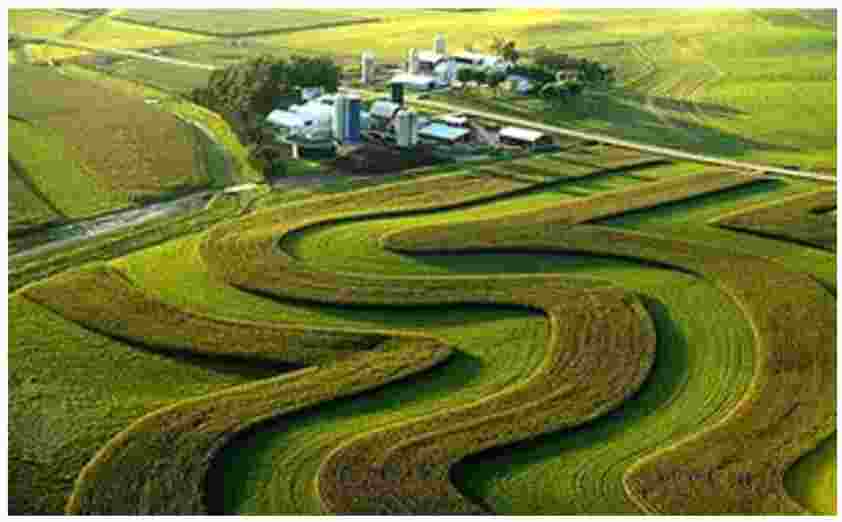
- In this system, the terrace includes grassed waterways and point rows. This kind of system requires less input to arrange them, but they are quite tricky for farming because of space irregularities.
2. Bench Terracing:-
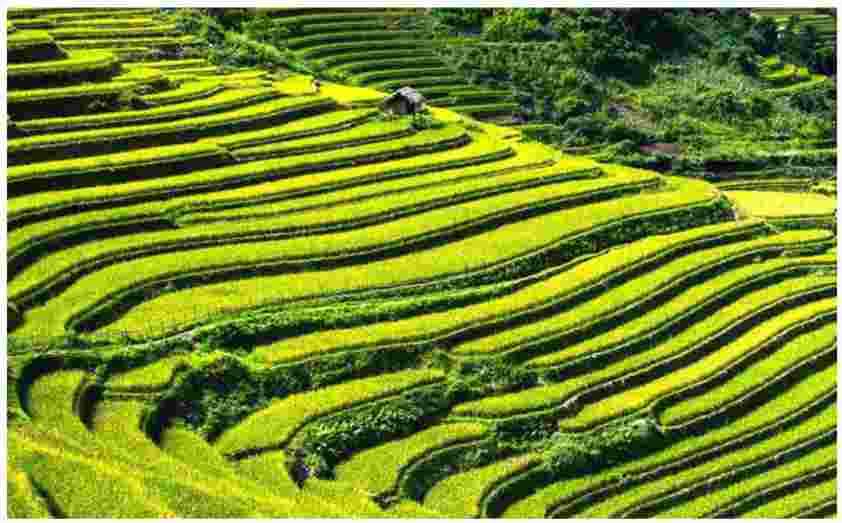
- In farming, the bench system resembles benches or stairs across a slope with platforms having flat or nearly flat forms arranged at regular intervals. This system of agriculture is commonly used for growing rice.
3. Parallel Terracing:-
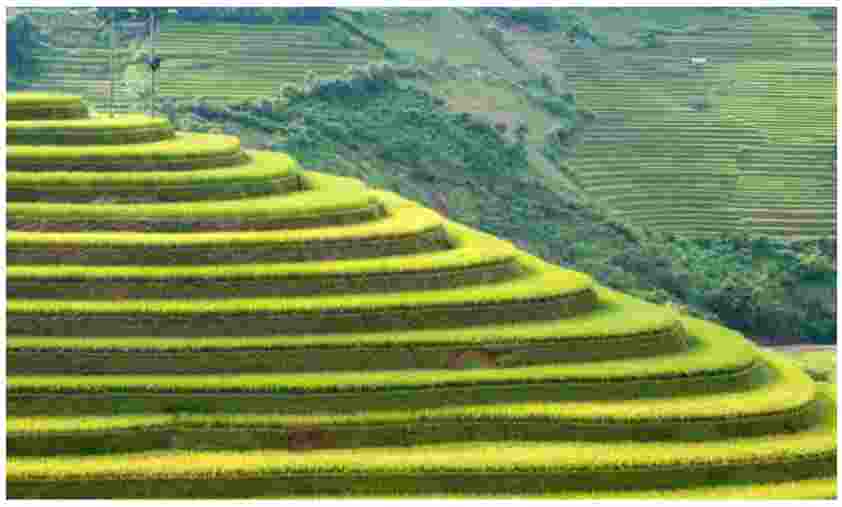
- The construction of a Parallel system is the easy way for farming tasks, and that’s why keep it as parallel as possible. However, they are made through land levelling if the slope does not allow that. Therefore, this farming highly requires different implements.
Types Of Terrace Farming
1. Grassed Back-Slope Terrace Farming:-
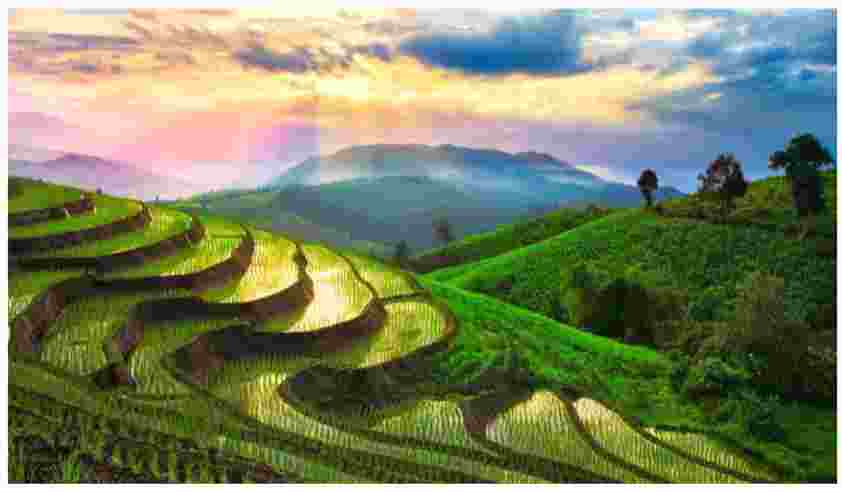
- The farming type is an example of perennial terracing. As the name suggests, the back slope cover is perennial grass. In the given terrace farming technique, the back slope is not cultivated, unlike the main part. The main part includes the soil taken from the downhill upwards, with further leveling for farming.
2. Narrow-Base Terrace Farming:-
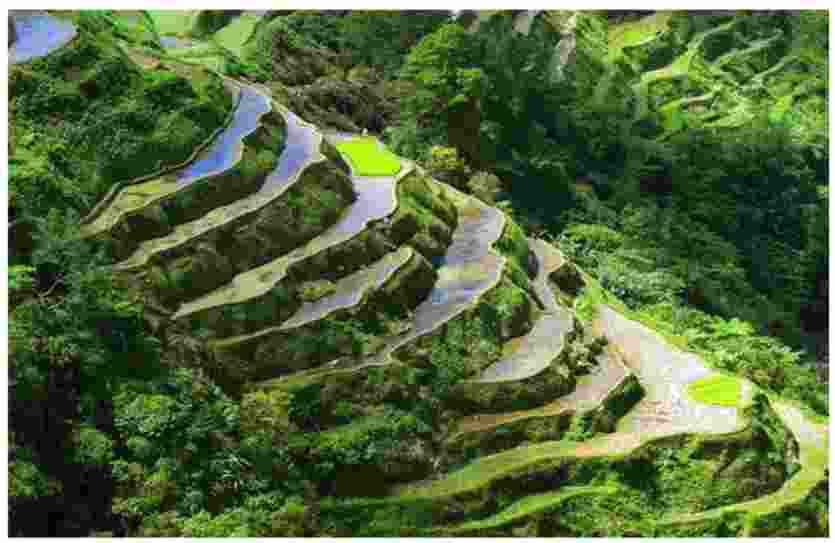
- This type is another example of perennial terracing, but in this case, permanent vegetation covers both the front and back sides. These parts are not cultivated. Like with the grassed back slope, the earth is usually moved downhill. Yet, this is the steepest terracing type, requiring less amount of earth for platforms.
3. Broad-Base Terrace Farming:-
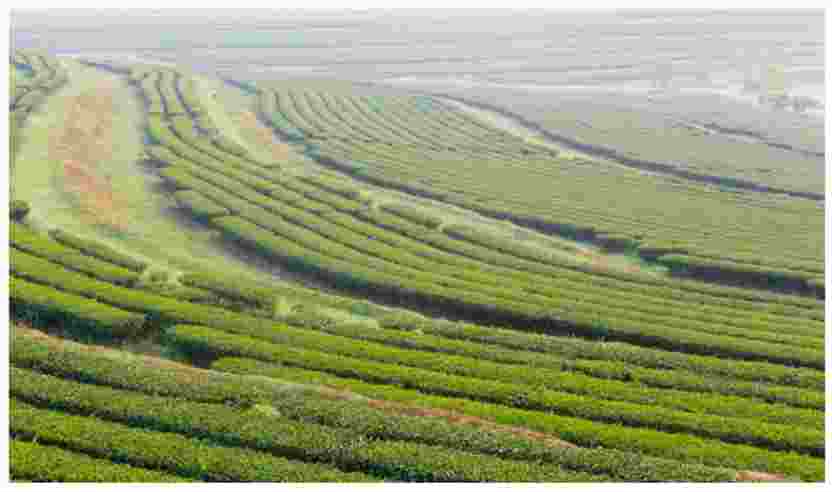
- The farming technique is suitable for the gentlest hills, and terrace cultivation embraces all the slopes. For this reason, they should suit machinery needs, and the terrace spacing is typically equal to the number of machinery swaths. Crossing the ridges is prohibited – the equipment is supposed to move between the terraces through designated passages.
Famous Terrace Farming Around The World
Asia
- The most well-known use of terrace farming are the rice paddies of Asia. Rice needs a lot of water, and a flat area that can be flooded is best. But a big enough area of ideal topography is hard to find, which is why the smarter way is to use terrace farming.
1.Banaue Rice Terraces:-

The Banaue Rice Terraces were named the UNESCO World Heritage Site in 1995, and are known as the eighth wonder of the world. It is located in the heartlands of the Cordilleras mountains of the Philippines.
The Banaue Rice Terraces fields were carved out by hand by the Ifugao tribes and are thought to have been successfully producing rice for almost 2,000 years.
2.Sa Pa Terraces:-
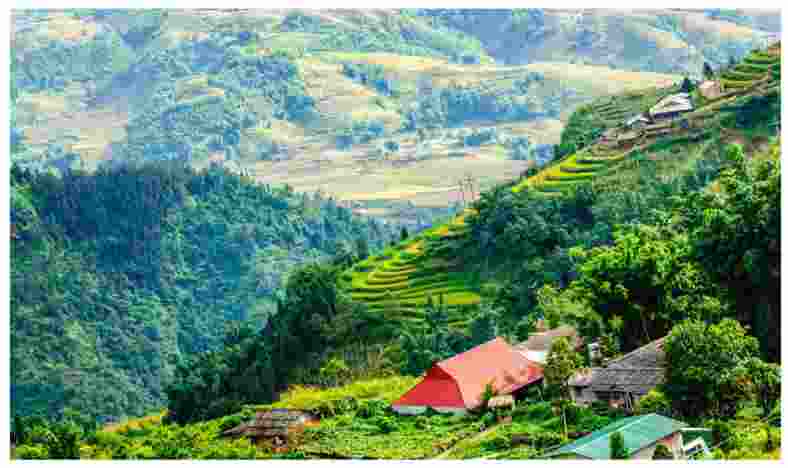
Sa Pa Terraces is among the most visited tourist destination in Vietnam which are located in Muong Hoa valley. This is in between Sa Pa district and the Fansipan Mountain not far from the Chinese border.
The local mountain people grow vegetables, corn, and rice on these terraces. However, because of the climate, it can only produce one rice harvest per year.
3.Hani Terraces:-
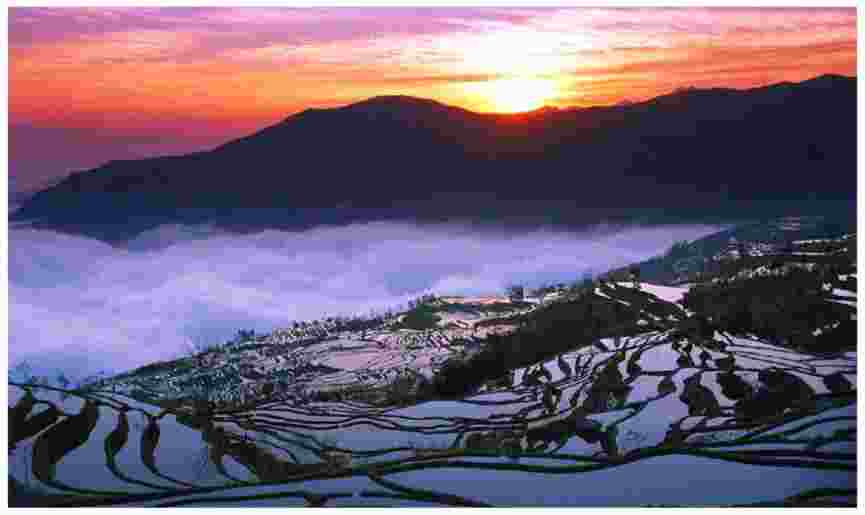
Hani Terraces are also carved by hand by the Hani people. Situated below the villages on the side of the Ailao Mountains in Yuanyang, China.
These terrace fields provided enough rice and fish for hundreds of thousands of people for over 1,000 years. Its rice terraces are a lush tropical paradise that is flooded with tourists from December to March for a beautiful view.
4.Longji Terraces:-
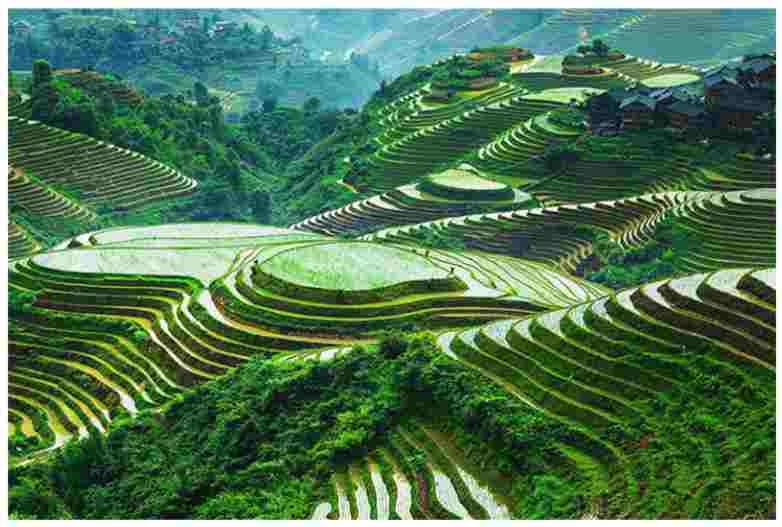
Longji meaning the Dragons’ Backbone was built more than five hundred years ago. The Longji Terraces were located in Longsheng which is about 2 hours away from Guilin in China.
Longji Terraces are the outcome of Longing’s limited agricultural land and water supply.
5.Bali Rice Terraces:-
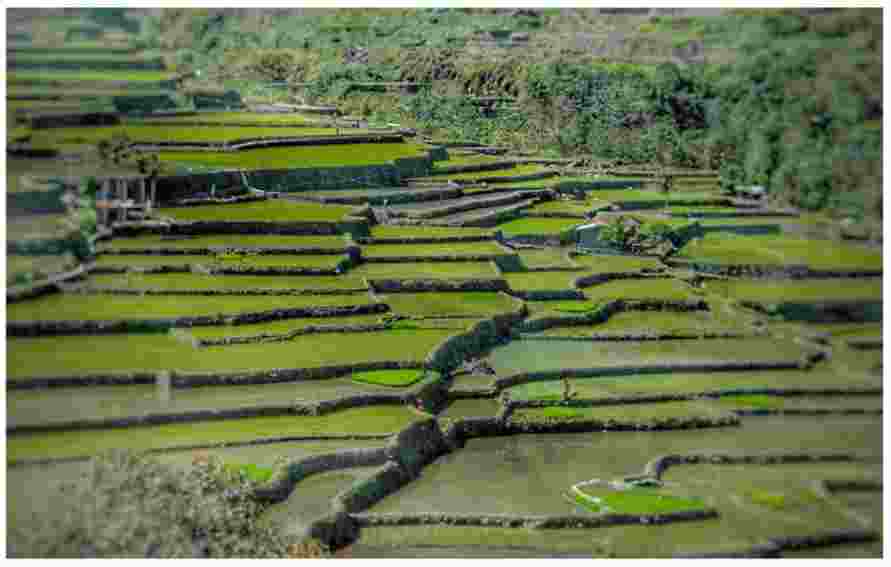
The Bali Rice Terraces in Indonesia were also carved by hand with the help of basic tools and are carried out by generations.
In Bali, they have a well-organized social order called Subak which manages the irrigation strictly on schedule and are fairly distributing the water.
The Mediterranean
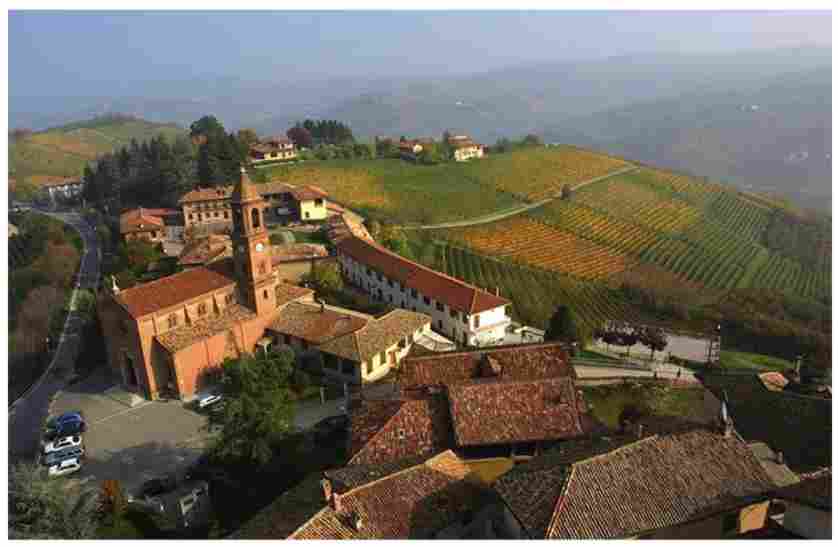
- Countries around the Mediterranean Sea have used terrace farming for centuries to cultivate vineyards and orchards of olive, cork, and fruit trees. Lining hillsides and the steep slopes leading down to the coast are terraced areas that have been transformed into productive agricultural land.
1.Lavaux Region:-
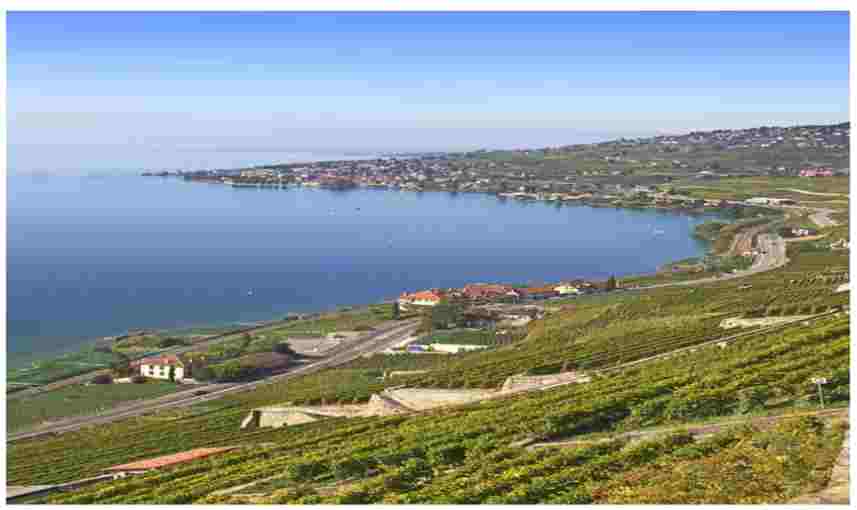
- The Lavaux region in Switzerland also makes use of terrace farming for vineyards that line the north side of Lake Geneva. The terraces can be traced all the way back to the 11th century.
2. Douro Valley:-

Douro Valley is part of northern Portugal and known as the home of port wine. The hillside of Douro Valley is veiled with terrace grounds of vines tripping down to its river banks.
It becomes a spectacular display of colors all year long as the vines grow.
South America
- Civilizations in South America were also tapping into the potential of terrace farming long ago to feed large populations.
1. Machu Picchu:-
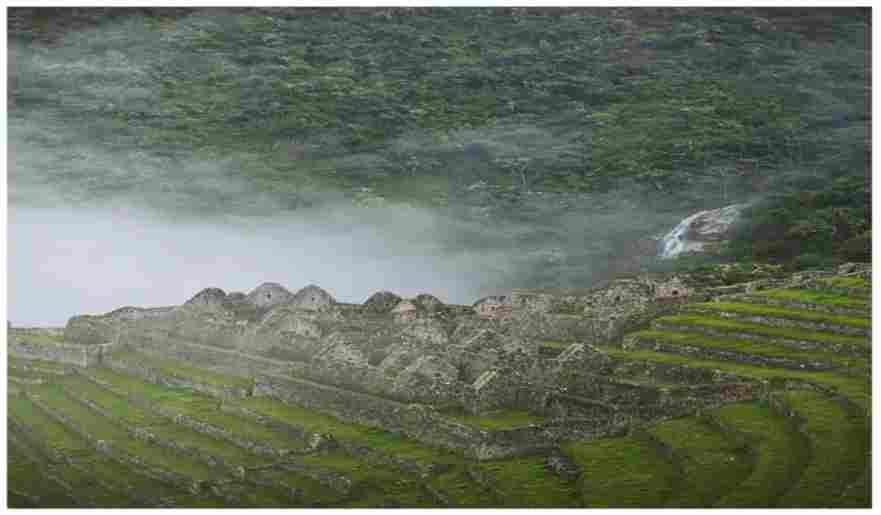
- Machu Picchu in Peru is one of the most spectacular and impressive ancient sites in the world. Machu Picchu’s narrow steps were made from stone blocks, with thousands of pathways and terraces, connecting plazas, cemeteries, and buildings.
2. Inca Pisac:-
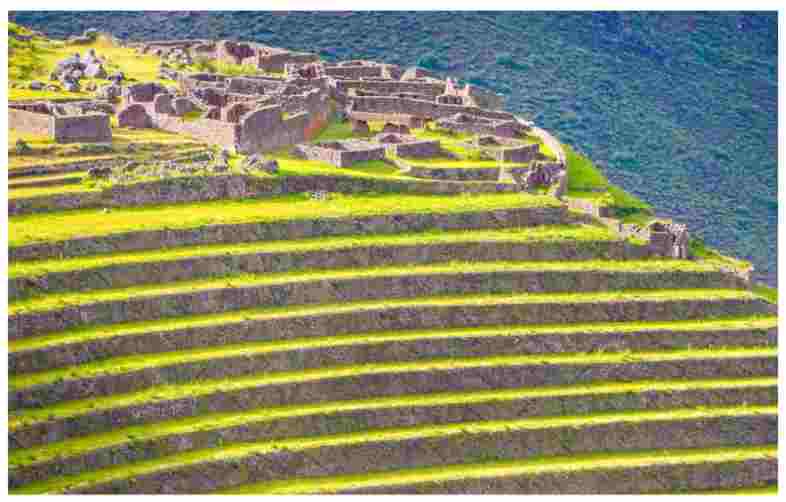
- The Inca Pisac in Peru was built by the Incas and is still being utilized today. The mountainous terraces of Inca Pisac were made of 16 different cultivation areas. The terraces include religious temples, military citadel, and homestead and oversee the Sacred Valley of the Salcantay Mountains.
3. Salinas De Maras:-
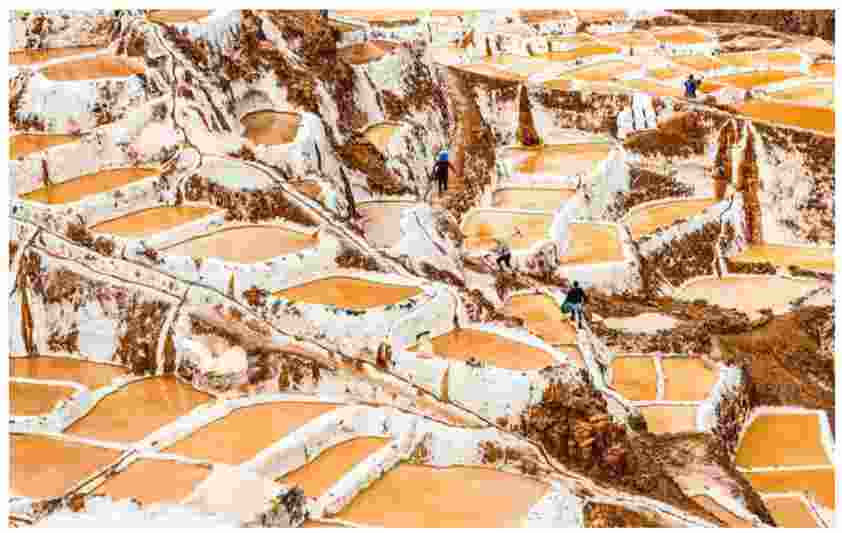
- Salinas de Maras or the Inca salt pans in Peru are known to be producing salts for centuries. Just like Asian rice terraces, these salt terraces are passed on through generations. It consists almost 3,000 man-made terrace salt pans that when reflected with the sunset it makes the salt pans to appear like it is made of gold.
4. Choquequirao:-
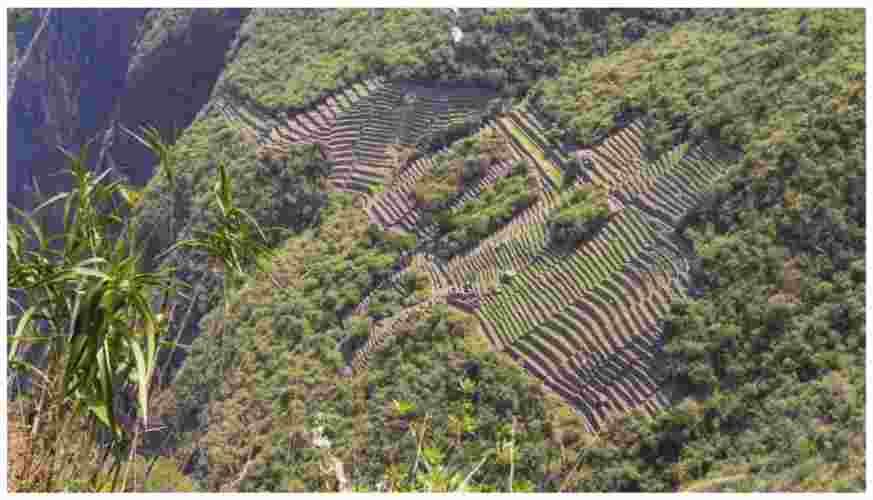
- Choquequirao meaning Cradle of Gold is another Peruvian terrace agricultural site. It is situated at the boundary of Cuzco and Apurimac and is made of 180 steps which are built completely different from the Machu Picchu style.
Famous Terrace Farming Sites In India
1. Meghalaya:-

- Bun or terrace cultivation is practised widely in slopes and valleys and in Meghalaya. This cultivation method has been prevalent for the last 3 decades. It provides an improved production system, helps conserve soil moisture, and prevents land degradation and soil erosion. The total agricultural land in Meghalaya, 62% is used for food grains, 25% for cash crops, 9% for horticultural crops and the rest 4% is used for raising miscellaneous crops. Potato is the most important commercial agricultural crop, covers about 7% of the total agricultural area of the state. It was introduced in Khasi hills by David Scott in the early part of the 19th century and grown mainly in the terrace fields of the high altitudes of Khasi hills.
2. Manipur:-
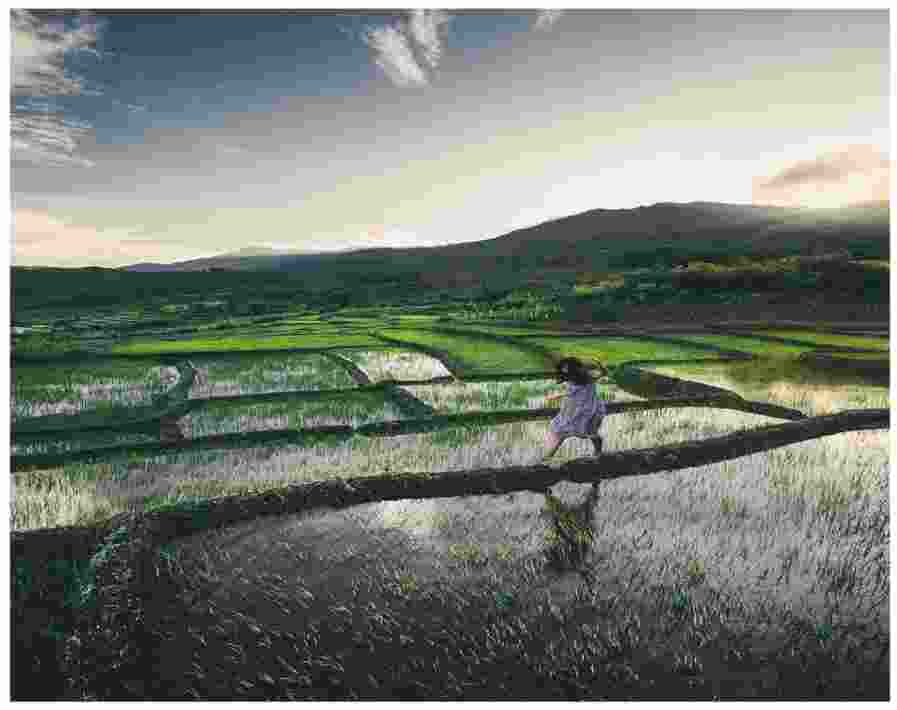
- Manipur, surrounded by nine sub–Himalayan Ranges, is home to some beautiful terrace farms. Which prefer wet paddy cultivation which is an old age practice and they have perfected over the centuries. It is an integral part of terracing on the hill slope agriculture. The wet paddy terraces appear big saucer shapes upon the hills and valleys. On the hills, terraces are engraved on low hill slopes while near the riverside terrace walls are layered with stones. The terraces were constructed hundreds of years ago and it is one of the marvels of the hills architect.
3. Himachal Pradesh:-
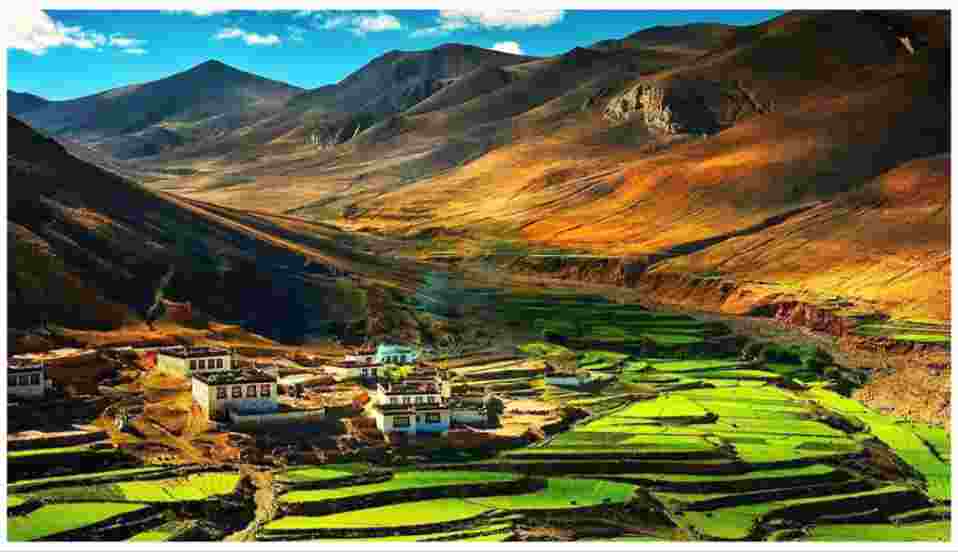
- The paddy plantation in the scenic mountain villages. The Hanogi Bridge over the River Beas connects terrace farms to Hanogi Mata Mandir. Located in the Mandi District of Himachal Pradesh, these farms have an amazing view of the surroundings.
4. Uttarkhand:-
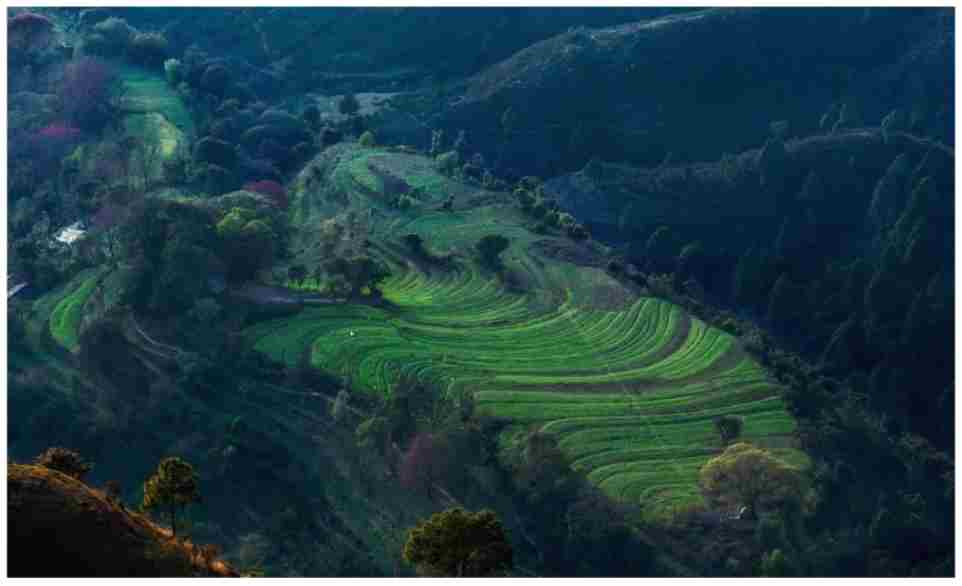
- The majority of people in Uttarakhand live in rural areas, 71% depend on rainfed agriculture, practiced through terrace farming on hill slopes. Step Farms near Satgarh Village on Pithoragarh to Ogla Road is a pleasant sight to behold. Chaubatia Gardens in Ranikhet has one of the most scenic terraces in India.
5. Anaimalai Hills:-

- The Anaimalai, also known as the Elephant Mountains, are a range of mountains in the southern Western Ghats of central Kerala and span the border of western Tamil Nadu in Southern India. The tea and coffee plantations of the Anamalai Hills in the Western Ghats are terrace farms.
Advantages Of Terrace Farming
Terrace farming prevents the washing away of soil nutrients by the rains. This leads to the growth of healthy crops.
Every step has an outlet that channels water to the next step. This helps in keeping some areas dry and others wet
At very high altitudes, other crops apart from rice can be grown. This is because rice does not do well at high altitudes.
Terraces help in the reduction of soil erosion and water loss.
Terraces trap rainwater allowing the people to engage in the cultivation of water-intensive crops such as rice.
Terrace farming is able to turn the moist idle land into productive farms leading to high food security in the world. It also helps in retaining the soil nutrients in the farms.
Increases farm ability and land productivity of sloped fields.
Contributes to water conservation- slows down and reduces water runoffs, improves rainwater harvesting.
Prevents soil erosion by decreasing rill formations.
Boosts soil conservation. Adds to ecosystem diversity.
Reduces sedimentation and water pollution. Water stays long enough for heavy particles to settle down and prevent downstream sedimentation and pollution of water bodies, but short enough not to harm crops.
Increases food production by adjusting hilly land for farming.
Limitations Of Terrace Farming
Terracing requires huge inputs of labor to construct and maintain, and when not properly maintained, the effects can be catastrophic. Unmaintained terraces can lead to mudslides, the creation of deep gulleys,s and increased soil erosion, particularly in sandy soils or on extremely steep terrains. Hence it is expensive as it is labor intensive.
Terrace farming also leads to a reduction in soil quality due to the leaching process.
Terrace farming can be disadvantageous during the rainy and monsoon seasons, with soil getting oversaturated. The water overflow can cause runoffs and can lead to landslides when not monitored well
Climate change has also made maintaining historical terraces much more difficult, as the seasonal changes often bring drought, floods, and other extreme weather conditions that may not have been common in the area previously.
Conclusion
It may be concluded that terraces could considerably reduce soil loss due to water erosion if they are well planned, correctly constructed, and properly maintained. There are many examples showing that terraces have to be maintained to prevent processes leading to land degradation such as excessive soil erosion, gully formation, and land sliding.
There is a large variety of terrace types, each adapted to certain landscapes with various slope gradients, but all terraces can be divided into three groups: bench terraces, contour terraces, and parallel terraces. All of these three terrace types could be effective regarding soil and water conservation, there is no such thing as the best terrace type because it all depends on local conditions. The most important aspect of terracing is that it has to be combined with additional soil conservation practices, of which the most important one is the maintenance of a permanent soil cover.
A very important point regarding terraces or any soil and water conservation practice is that most farmers are more concerned with production than with conservation. Therefore, the challenge is to develop conservation practices that are also productive. The ancient farming techniques such as terracing may provide a good basis for that, unfortunately, it has never been shown that terraces increase yield, but it has been shown by many researchers that terraces could provide a basis for good farming that aims to keep fertile soil resources in place and in a good productive state.
Top 13 Interesting Facts About Terrace Farming
The purpose of terrace farming on slopes is to decrease water flows and prevent soil erosion. However, using it in the mountains is not the only option. Opposite graduated step-like platforms, there are relatively level ones on gentle slopes or wavy lands, which shows that terracing applies to different field elevations.
Terrace alignment depends on the slope steepness and the soil type. In particular, it is not suitable when lands are prone to sliding.
The commonly used terracing systems are bench, contour, and parallel terraces. Their names give an idea of their layout.
Intensive terrace farming is believed to have been practiced before the early 15th century AD in West Africa.
Terraced farming was developed by the Wari culture and other peoples of the south-central Andes before 1000 AD, centuries before they were used by the Inka, who adopted them.
The earliest terraces were used by many tribal groups, notably the Mafa, Ngas, Gwoza, and the Dogon.
The terraces of rice found in the Philippines Cordilleras have been acknowledged as a UNESCO World Heritage Site.
Terrace farming is commonly used in Asia by rice-growing countries such as Vietnam, the Philippines, and Indonesia.
Terrace farming is also generally used in islands such as the Canary Islands because they have hilly terrain.
Aside from the cultivation of rice, terraces are also used to grow potatoes and maize.
Three of the most important crops that are grown using terrace farming are rice, wheat, and barley.
In very high altitudes, different crops apart from rice can be grown, because rice does not do well in high altitudes.
Terracing is also used for sloping terrain; the Hanging Gardens of Babylon may have been built on an artificial mountain with stepped terraces, such as those on a ziggurat.



